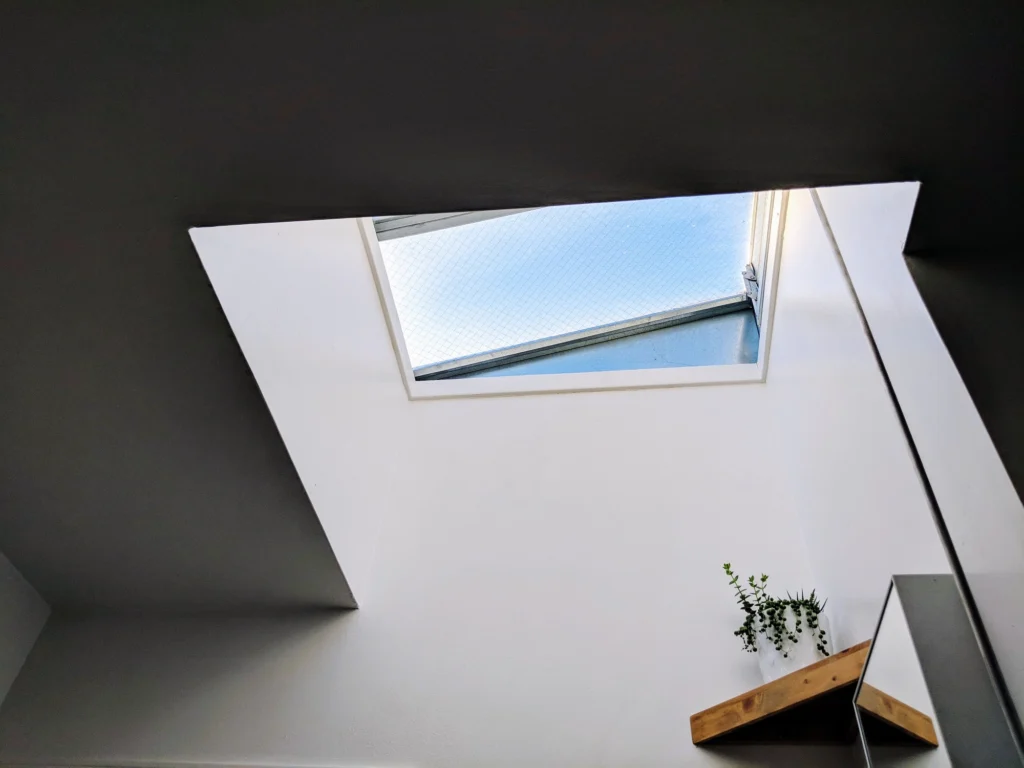Skylights increase natural light coming into your home and can also create additional ventilation. They’re a convenient way to open up limited areas so smaller rooms appear lighter and airier. Plus, skylights enhance your home’s aesthetic appeal and provide you with scenic views of the outdoors.
There are a variety of different types of skylights, and each one comes with its own purpose and attributes. Likewise, each type of skylight requires specific installation, and finding the right skylight contractor is essential to ensure your skylight fits your home and roof’s structure. The good news is you can install skylights on any type of roof, including metal roofs.
To help you choose the best skylight for your home and how to find the right person to install it, we put together a guide about the various types of skylights available. We’ll walk you through how to choose one, the benefits of a skylight, what it might cost, and answer some frequently asked questions.
In this article:
- Common Styles and Types of Skylights for Homes
- Choosing the Right Skylight for Your Home
- Benefits of Skylights
- How Much Does Skylight Installation Cost?
- Choosing a Contractor to Install a Skylight
- Frequently Asked Questions
Common Styles and Types of Skylights for Homes
| Type of Skylight | Features | Benefits |
| Fixed Skylights |
|
|
| Vented Skylights |
|
|
| Dome Skylights |
|
|
| Tubular Skylights |
|
|
| Solar Vented Skylights |
|
|
| Flat Roof Skylights |
|
|
| Pyramid Skylights |
|
|
Several types of skylights exist for your home, though a few stand out as the most common options. As we previously stated, each style of skylight has unique characteristics and benefits. Consider the following:
Fixed Skylights
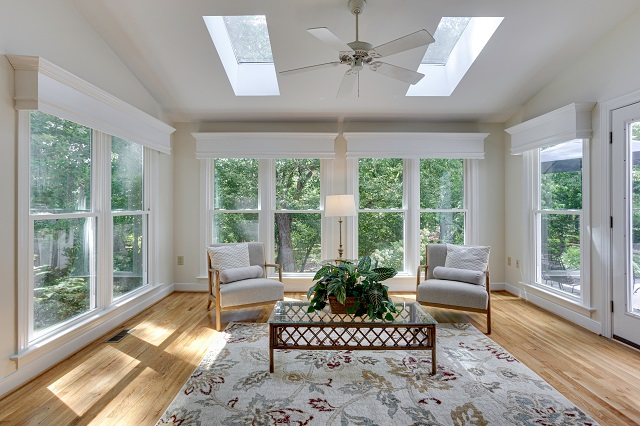
One of the most common and basic styles of skylights is the fixed skylight. As the name implies, it’s a window that’s fixed in place — it doesn’t open, but it lets in plenty of natural light. This type of skylight is used in areas where additional ventilation is not needed.
The SIG Skylights FMB Deck Mounted Skylight is a fixed skylight that’s suitable for pitched roofs. It features an extra-wide, ribbed flange that provides self-flashing, so it’s leak-free. The frame also includes a drain that removes condensation that may occur due to excessive moisture.
Vented Skylights
Another common style is the vented skylight. Vented skylights are windows that can be opened, which allows fresh air into the room, giving you both natural light and ventilation. These types of skylights are typically used in kitchens, bathrooms, or other areas that need additional airflow — often where excess moisture may accumulate.
Vented skylights can be either electric or manual. An electric skylight features a motor that opens and closes the window, while a manual skylight requires a hand-crank or handle. Some vented skylights can be used with a remote control.
Dome Skylights
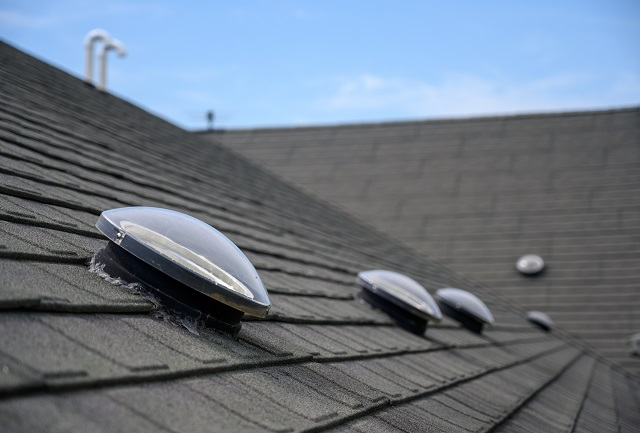
As their name suggests, dome skylights are dome-shaped, allowing light to enter the space from multiple angles while also offering greater privacy (as they’re harder to see through the rounded shape compared to flat-paned skylights) and reducing potential glare. The curved design of dome skylights can add aesthetic appeal to a home’s architecture.
Also called skylight domes, bubble skylights, dome rooflights, bubble rooflights, or bubble dome skylights, dome skylights are typically made from lightweight and impact-resistant materials like acrylic or polycarbonate. Their dome shape also helps these skylights shed water, snow, and debris more efficiently, reducing the risk of leaks.
Tubular Skylights
Tubular skylights, similar to dome skylights, are designed for small areas and are sometimes referred to as sun tunnels. This style of skylight is cylindrical, so it can capture and diffuse sunlight through a reflective tube. Tubular skylights are made for areas where traditional skylights can’t fit.
The Natural Light Energy Skylight 10-inch Tubular Skylight is designed to illuminate up to 150 square feet, which is the equivalent of 300 watts of power. This tubular skylight comes with aluminum flashing, a condensation release system, and a 25-year product warranty.
Solar Vented Skylights
Solar-vented skylights use solar panels that can generate enough electricity to either help power your home or operate the opening and closing of the skylight itself. This style may also come with a remote control and be outfitted with sensors that automatically close the window if excess moisture is detected, such as when it rains.
Flat Roof Skylights
Flat roof skylights are designed for flat or low-sloped roofs and are usually seen on commercial buildings. However, they can also be used for homes with flat roofs.
They’re typically square or rectangular and have a lower profile compared to other types of skylights, which makes them easier to integrate with flatter roofing surfaces. They also feature glaze and insulation specifically designed for the thermal characteristics of flat roofs. However, the need to integrate these skylights seamlessly with flat roofing styles means the design options are more limited compared to other types of skylights.
Pyramid Skylights
Pyramid skylights are made for especially large buildings or structures to provide natural light for larger spaces. Pyramid skylights are crafted with multiple panels that form the shape of a pyramid to let in the maximum amount of light possible.
Choosing the Right Skylight for Your Home

To help you choose the right skylight for your home, consider the following factors:
- Location: Where you want the skylight to be installed in your home is a major determining factor as to what kind of skylight should be installed. Consider how much light is needed or whether the space needs additional ventilation. For instance, a bathroom or kitchen may benefit from a vented skylight for ventilation, while a fixed skylight may be all that’s needed to provide natural light in your living area or bedroom.
- Room Size: The size of the room where you want the skylight matters. The skylight should be large enough to provide adequate light but not so large that it becomes a safety hazard.
- Roof Shape: The right skylight for your home must be compatible with the shape of the roof. For instance, a low-sloped or flat roof requires a flat roof skylight, while a pitched roof can feature a variety of skylight styles.
- Climate: The proper skylight for your roof should be able to withstand the climate in your area. The style you choose may impact the energy efficiency of your home.
- Cost: Consider the cost of the skylight and whether there’s a warranty offered. Skylights can range in price from a few hundred to several thousand dollars.
- Design: Consider the aesthetic style and design of your chosen skylight so that it complements the look of your home and the room where it will be installed.
- Reviews and Testimonials: Read past customer reviews and testimonials to help find the right skylight and choose a qualified contractor for your roofing needs.
Benefits of Skylights

Skylights offer many benefits to homeowners, especially increasing natural sunlight and providing fresh air, both of which can help improve mood. Other benefits include:
- Energy efficiency: Skylights can help improve the energy efficiency of your home by letting in natural light during the day. This can help reduce reliance on artificial lighting, which can save money on your energy bills.The Velux Laminated Fixed Non-Vented Deck Mounted Skylight is an energy-efficient, fixed skylight with laminated, Low-E argon glass. It’s versatile for a number of different roof types and features a pre-finished white interior wood frame. This skylight has a no-leak installation system and comes with a 10-year hail warranty against glass breakage.
- Increased home value: Skylights can also increase the value of your home by enhancing curb appeal.
- Saves on space: Skylights help add more light and fresh air without taking up more wall or floor space.
- Versatility: Skylights come in many styles that are compatible with just about any type of space and roof.
How Much Does Skylight Installation Cost?
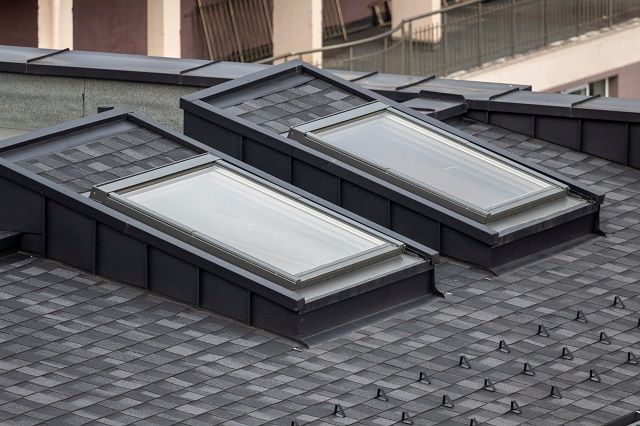
The cost of skylight installation varies and may range from hundreds to thousands of dollars. The overall cost depends on multiple factors, such as:
- Type of skylight: Basic skylights cost less than those with additional features.
- Type of roof: Do you have a flat or steep roof?
- Condition of roof: Does your current roof need repairs?
- Size of the skylight: Smaller skylights cost less than larger ones.
- Location of the skylight: Where you live and the climate you experience could alter the cost.
- Materials used: The type of material used impacts the cost.
- Labor costs: Installation costs vary depending on the complexity of the job.
- Permits and inspections: Cost may increase if permits need to be pulled or inspections scheduled.
- Maintenance: The overall maintenance should be factored into the bottom-line cost.
Choosing a Contractor to Install a Skylight
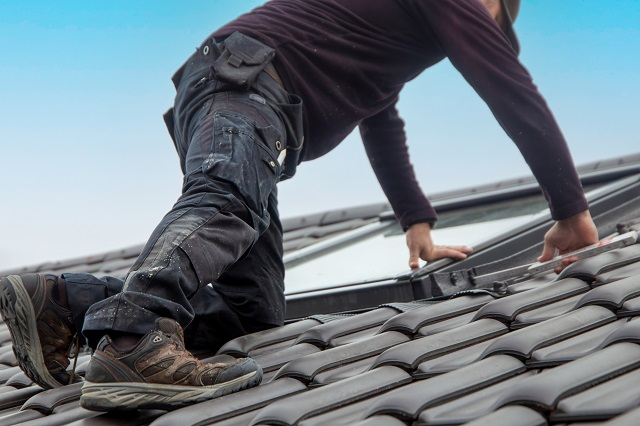
Work with a qualified skylight contractor to help you find and install the right skylight for your home. Consider vetting your options by reading reviews and testimonials, listening to word of mouth, and scoping out professional roofing companies.
Don’t forget to obtain quotes from several contractors before making a decision about which skylight to install to ensure you are getting the best possible price.
Skylights can be difficult to install, so it’s important to hire a professional. This helps ensure the skylight is installed correctly and is safe to use. Look at professional status symbols like proper licenses and insurance, which can tell you your skylight contractor has the appropriate skill set to work on your home.
Ranch Roofing is an experienced roofing contractor with decades of experience in the greater Boston area. Our skylight window installation and replacement experts will help you choose the best type of skylight for your space and roofing system, and we’ll handle the entire process, from estimate to post-installation cleanup. For more information, or to schedule a free skylight estimate, contact us today!
Frequently Asked Questions
What are the most common skylights for homes?
The most common skylights are fixed, vented, and solar. Fixed skylights are compatible with various types of roofs, rooms, and spaces. Vented skylights are common in bathrooms and kitchens.
Which skylight is the best at resisting leakage?
A curb-mounted skylight can prevent leaks better than deck-mounted skylights. They’re more flexible and feature a larger glass area.
But some skylights come with extra flashing to seal the roof better to prevent leakage. Check with the manufacturer’s description of the particular skylight you want to purchase.
What is the average lifespan of a skylight?
The average lifespan of a skylight is between 8 and 15 years, but some skylights can last up to 20 or 30 years.
What is a common problem with skylights?
Some common problems with skylights include:
- Condensation and fogginess
- Leaks and cracks
- Glare and excess light
- Wear and tear
- UV damage
- Discoloration
- Unwanted drafts
- Ice dams
